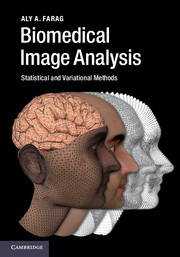Book contents
- Frontmatter
- Dedication
- Contents
- Preface
- Nomenclature
- 1 Overview of biomedical image analysis
- Part I Signals and systems, image formation, and image modality
- Part II Stochastic models
- Part III Computational geometry
- Part IV Variational approaches and level sets
- Part V Image analysis tools
- 11 Segmentation: statistical approach
- 12 Segmentation: variational approach
- 13 Basics of registration
- 14 Variational methods for shape registration
- 15 Statistical models of shape and appearance
- Index
- References
14 - Variational methods for shape registration
from Part V - Image analysis tools
Published online by Cambridge University Press: 05 November 2014
- Frontmatter
- Dedication
- Contents
- Preface
- Nomenclature
- 1 Overview of biomedical image analysis
- Part I Signals and systems, image formation, and image modality
- Part II Stochastic models
- Part III Computational geometry
- Part IV Variational approaches and level sets
- Part V Image analysis tools
- 11 Segmentation: statistical approach
- 12 Segmentation: variational approach
- 13 Basics of registration
- 14 Variational methods for shape registration
- 15 Statistical models of shape and appearance
- Index
- References
Summary
Variational methods are based on continuous modelling of input data through the use of partial differential equations (PDE), which benefits from the well-developed theory and numerical methods on PDEs. A novel variational framework for global-to-local shape registration is presented. A new sum-of-squared-differences (SSD) criterion, which measures the disparity between the “implicit” representations of the input shapes, is introduced to recover the global alignment parameters. This new criterion has some advantages over existing ones in accurately handling scale variations. Complementary to the global registration field, the local deformation field is explicitly established between two globally aligned shapes, by minimizing an energy functional which incrementally updates the displacement field while keeping the corresponding implicit representation of the globally warped source shape as close as possible to a “signed distance” function. The optimization is performed under regularization constraints that enforce the smoothness of the recovered deformations. The overall process leads to a coupled set of equations that are simultaneously solved through a gradient descent scheme. The finite element (FE) approach for solving PDEs may be used to validate the performance of the shape registration technique. This chapter provides a holistic approach for shape registration.
Introduction
The process of registering shapes is based on three main components, namely (1) the way to represent the shapes, (2) the transformation model, and (3) the mathematical framework selected to recover the registration parameters. The following section briefly reviews each of these components.
Information
- Type
- Chapter
- Information
- Biomedical Image AnalysisStatistical and Variational Methods, pp. 387 - 416Publisher: Cambridge University PressPrint publication year: 2014
